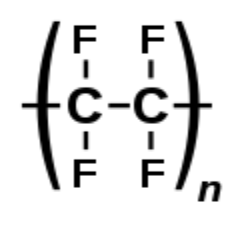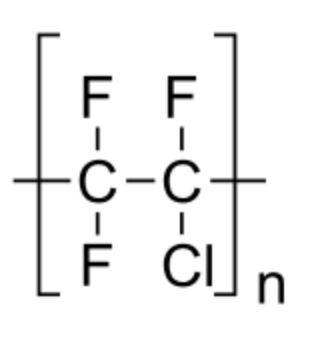
Which pair of polymers have similar properties?
(A) Nylon, PVC
(B) PAN,PTFE
(C) PCTFE,PTFE
(D) Bakelite, alkyl resin
Answer
219k+ views
Hint: Any of a group of organic or synthetic compounds known as polymers are made up of macromolecules, or very large molecules, which are just multiples of simpler chemical building blocks known as monomers. Numerous natural and man-made materials, as well as a large portion of the components in living things, are composed of polymers.
Complete Step by Step Solution:
In polymer chemistry, polymerization is the process of joining monomer molecules to form polymer chains or three-dimensional networks by a chemical reaction. Different techniques exist to classify the various types of polymerization. Due to the functional groups contained in the reactants and their inherent steric effects, polymerization in chemical compounds can take place through a variety of reaction processes that vary in complexity.
Numerous applications can be found for polytetrafluoroethylene (PTFE), a synthetic fluoropolymer of tetrafluoroethylene.
Polytetrafluoroethylene, a high-molecular-weight polymer made entirely of fluorine and carbon, is a fluorocarbon solid. Due to the strong electronegativity of fluorine in fluorocarbons, which exhibits reduced London dispersion forces, PTFE is hydrophobic, meaning that neither water nor things containing water can wet it. One of the lowest coefficients of friction of any substance is found in PTFE.

The thermoplastic chlorofluoropolymer known as polychlorotrifluoroethylene (PCTFE or PTFCE) has the molecular formula \[{\left( {{\text{C}}{{\text{F}}_{\text{2}}}{\text{CClF}}} \right)_{\text{n}}}\], where n is the number of monomer units in the polymer molecule. It is comparable to polytetrafluoroethene (PTFE), except instead of tetrafluoroethene, it is a homopolymer of chlorotrifluoroethylene (CTFE). Of all plastics, it transmits water vapour at the slowest rate.

The carbon backbone of both PCTFE and PTFE is the same, so they might have the same chemical properties.
Hence option (C) is correct.
Note: Due to the functional groups contained in the reactants and their inherent steric effects, polymerization in chemical compounds can take place through a variety of reaction processes that vary in complexity. Alkenes undergo comparatively straightforward radical reactions to create polymers in more straightforward polymerizations; in contrast, substitution reactions at a carbonyl group need more complicated synthesis because of the way the reactants polymerize. The polymerization of alkanes is also possible, but only with the aid of potent acids.
Complete Step by Step Solution:
In polymer chemistry, polymerization is the process of joining monomer molecules to form polymer chains or three-dimensional networks by a chemical reaction. Different techniques exist to classify the various types of polymerization. Due to the functional groups contained in the reactants and their inherent steric effects, polymerization in chemical compounds can take place through a variety of reaction processes that vary in complexity.
Numerous applications can be found for polytetrafluoroethylene (PTFE), a synthetic fluoropolymer of tetrafluoroethylene.
Polytetrafluoroethylene, a high-molecular-weight polymer made entirely of fluorine and carbon, is a fluorocarbon solid. Due to the strong electronegativity of fluorine in fluorocarbons, which exhibits reduced London dispersion forces, PTFE is hydrophobic, meaning that neither water nor things containing water can wet it. One of the lowest coefficients of friction of any substance is found in PTFE.

The thermoplastic chlorofluoropolymer known as polychlorotrifluoroethylene (PCTFE or PTFCE) has the molecular formula \[{\left( {{\text{C}}{{\text{F}}_{\text{2}}}{\text{CClF}}} \right)_{\text{n}}}\], where n is the number of monomer units in the polymer molecule. It is comparable to polytetrafluoroethene (PTFE), except instead of tetrafluoroethene, it is a homopolymer of chlorotrifluoroethylene (CTFE). Of all plastics, it transmits water vapour at the slowest rate.

The carbon backbone of both PCTFE and PTFE is the same, so they might have the same chemical properties.
Hence option (C) is correct.
Note: Due to the functional groups contained in the reactants and their inherent steric effects, polymerization in chemical compounds can take place through a variety of reaction processes that vary in complexity. Alkenes undergo comparatively straightforward radical reactions to create polymers in more straightforward polymerizations; in contrast, substitution reactions at a carbonyl group need more complicated synthesis because of the way the reactants polymerize. The polymerization of alkanes is also possible, but only with the aid of potent acids.
Recently Updated Pages
Is PPh3 a strong ligand class 12 chemistry JEE_Main

Full name of DDT is A 111trichloro22bispchlorophenyl class 12 chemistry JEE_Main

Sodium acetate on heating with soda lime produce A class 12 chemistry JEE_Main

Find the isoelectric point pI of Lysine A 556 B 974 class 12 chemistry JEE_Main

The order of basicity among the following compounds class 12 chemistry JEE_Main

The number of isomers in C4H10O are a7 b8 c6 d5 class 12 chemistry JEE_Main

Trending doubts
JEE Main 2026: Application Form Open, Exam Dates, Syllabus, Eligibility & Question Papers

Derivation of Equation of Trajectory Explained for Students

Hybridisation in Chemistry – Concept, Types & Applications

Understanding the Angle of Deviation in a Prism

Understanding Collisions: Types and Examples for Students

Understanding Atomic Structure for Beginners

Other Pages
NCERT Solutions For Class 12 Chemistry Chapter 1 Solutions - 2025-26

NCERT Solutions for Class 12 Chemistry Chapter Chapter 7 Alcohol Phenol and Ether

NCERT Solutions ForClass 12 Chemistry Chapter Chapter 8 Aldehydes Ketones And Carboxylic Acids

JEE Advanced Marks vs Ranks 2025: Understanding Category-wise Qualifying Marks and Previous Year Cut-offs

Haloalkanes and Haloarenes Class 12 Chemistry Chapter 6 CBSE Notes - 2025-26

Solutions Class 12 Chemistry Chapter 1 CBSE Notes - 2025-26




